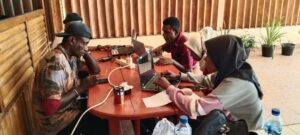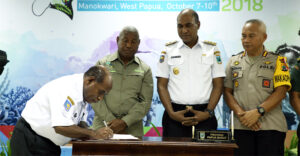
Having extraordinary natural wealth is not directly proportional to the welfare of the community. That is being experienced by West Papua, one of the provinces with extraordinary biodiversity both on land and at sea. The welfare of the people of West Papua can even be seen from the most basic subject, namely food security.
Based on the 2018 Indonesian Food Security Index (IKP) issued by the Food Security Agency, West Papua Province is in a food insecure area. The average IKP score of regencies / cities in West Papua is below the index score of 50 from the index score of 100. Tambrauw Regency has the lowest score, which is 26.03. Followed by Arfak Mountains Regency 30,25; Maybrat Regency 32,55; Teluk Wondama Regency 33.22; and Bintuni Bay Regency 37.23.
University of Papua academician Zulfikar Mardiyadi said, the behavior of food consumption in West Papua has changed. Sago and sweet potatoes are no longer considered a staple food. West Papua has matched other provinces in Indonesia which have high dependence on rice.
“Even though yams exist, there is sago, but the dependency is already above 95 percent. Practical if we go to homes anywhere in the interior of West Papua it is rare to find people consuming tubers. Tubers become a distraction and rice becomes the main, “said Zulfikar on the sidelines of the focus group discussion (FGD) for Food and Land Use (FOLU) organized by the EcoNusa Foundation and the World Resource Institute (WRI) Indonesia, Manokwari, West Papua.
According to Zulfikar, based on spatial data, rice fields in West Papua did not experience significant additions. Especially despite the rice field print program conducted by the Ministry of Agriculture. Paddy area, he said, has decreased due to the conversion of paddy fields to settlements as happened in the Sorong and Manokwari areas.
Citing the Unipa spatial data, in 1990, the area of rice fields was 1,150 ha, dry land agriculture was 7,007 ha, and mixed dry land agriculture was 93,104 ha. 27 years later the area of the three land cover areas increased only slightly: 1,567 ha of paddy fields, 6,709 ha of dry land agriculture, and 113,533 ha of dry land agriculture. In contrast to the area of plantation land cover, from 14,777 ha in 1990 to 67,292 ha in 2017.
In addition, Zulfikar said farming in the rice fields was not in accordance with the character of the people of the island of Papua who were accustomed to shifting cultivation. In addition, irrigated rice fields were not built to maximize the opening of paddy fields.
“That is the conjecture (West Papua does not have a big food security plan). From this data, the land that has increased dramatically is oil palm plantations, “said Zulfikar.
Meanwhile, food security cluster consultant Aser Rouw said, the level of food production in West Papua continued to decline. The decline in production occurred in rice and non-rice commodities. According to Aser, since 2010 the decline in food production has almost reached 20 percent.
“That of course requires strategies from the regions and also nationally how to improve food security in West Papua. Both sourced from own production or food that is supplied from outside. So far, the availability of food in West Papua is indeed more supplied from outside Papua, “said Aser.
In the FOLU workshop, in addition to food, discussions also took place to discuss the road map for the strategic sector of aquaculture (aquaculture) and ecotourism. Planning for aquaculture is important considering that the contours of the mountains of West Papua will be difficult to obtain animal protein. While the development of ecotourism received more attention after West Papua declared itself as a conservation province.
Aquaculture cluster consultant Silvi Estebay said, aquaculture development was proposed in three places; Fak-Fak Regency for seaweed commodities; Maybrat Regency for the development of freshwater ponds with tilapia and catfish commodities; and Manokwari Regency developed floating net cages.
“With environmentally friendly cultivation, the scale does not have to be large, but it can be continuous, available at any time, it can close the void (the fulfillment of animal protein). If sea fish can reach Pegaf with an expensive amount because of transportation, why don’t we close it to fulfill animal protein, right from pond maintenance, “Silvi said.
Silvi hopes that the development of aquaculture can increase the income of indigenous Papuans (OAP). When one community group has demonstrated the success of aquaculture development, according to Silvi, other community groups quickly adopt a similar method.
Then, ecotourism development was carried out in the Arfak Mountains District, Kaimana Regency, and Raja Ampat Regency. The three regencies offer alternative tourism potential that has not been explored to the maximum. Do not stop there, ecotourism can help OAP income with a minimal level of environmental damage.
Ecowista consultant Jonni Marwa said the three regions were selected based on height (mountain) and beach clusters. The three regions also have a Regional Tourism Development Master Plan (RIPDA), so that development plans can be more easily adopted by the district government.
“I think the attractions in West Papua are not a problem, quite a lot can be developed. Security and accessibility are still problematic. But that doesn’t matter, “Jonni said.







